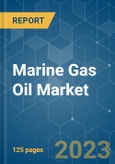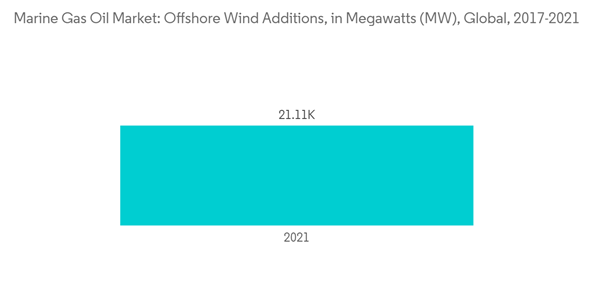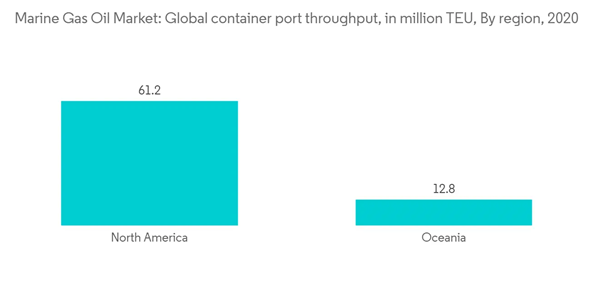The marine gas oil market is expected to register a CAGR of over 4% during the forecast period. In 2020, the market was negatively affected by the COVID-19 pandemic, as international trade and tanker movement fell due to a fall in global demand. However, now the market has rebounded and reached pre-pandemic levels. It is expected to witness steady growth during the forecast period.
This product will be delivered within 2 business days.
Key Highlights
- Because of the IMO 2020 convention that reduced the permissible limit of sulfur content in marine fuels, the demand for marine gas oil, which has a significantly lower sulfur content, is expected to incentivize its usage as a marine fuel. This is expected to drive the market during the forecast period.
- However, the relatively higher cost of IMO 2020-compliant low-sulfur Marine Gas Oil (MGO), compared to other marine fuels, is expected to restrain the market growth during the forecast period.
- However, developing new, advanced chemical additives for MGO that would improve engine efficiency and performance is expected to provide a significant growth opportunity for the market during the forecast period.
Marine Gas Oil Market Trends
Offshore Support Vessel (OSV) Segment to be the Fastest-Growing
- Offshore Support Vessels, or OSVs, are multipurpose specialty ships designed for operating on the oceans. They are used for various marine oil and gas and offshore wind industry applications, primarily for platform support, anchor handling, construction, maintenance, and more. They are integral to getting supplies and materials apart from building and repairing offshore equipment.
- As the global economy has recovered from the worldwide pandemic, energy demand has also recovered. Due to the economic effects caused by the fallout of the Russia-Ukraine conflict, global energy prices have been rising rapidly. To benefit from this high-price environment by raking in higher oil revenues, several oil exporting nations are rapidly expanding production capacity to increase export volumes.
- This has facilitated higher investments in the global upstream industry, especially in the offshore segment, where most projects are capital-intensive and feasible only in a high-price environment. Increasing investment in the offshore oil and gas industry is expected to be translated into higher demand for ocean-faring OSVs. This is expected to increase the demand for MGO from the OSV segment during the forecast period.
- Similarly, with energy prices spiking globally, another sector that is expected to witness massive growth is the offshore wind industry. As of 2021, according to the Global Wind Energy Council (GWEC), global offshore wind capacity stood at 57.2 GW at the end of 2021, with nearly 21.1 GW of new additions.
- The market is slated for massive growth during the forecast period, as the falling Levelised Cost of Electricity (LCOE) for electricity generated by offshore wind farms, coupled with rising demand for cheap, green energy, is expected to incentivize the construction and operation of new mega offshore farms. This is expected to drive the demand for OSVs, and subsequently, the OSV segment of the MGO market during the forecast period.
- As offshore oil and gas and wind investments keep rising, fueled primarily by rising global energy prices, the demand for OSVs is expected to increase rapidly. Due to this, the OSV segment is expected to be the fastest-growing segment in the MGO market during the forecast period.
Asia-Pacific to Dominate the Market
- The Asia-Pacific region is the largest in terms of cargo volume. As the demand for cargo vessels and tankers exporting goods and crude oil increases, the region is expected to dominate the MGO market during the forecast period.
- According to the 2021 Review of Maritime Transport published by the United Nations Conference on Trade and Development, in 2020, container port throughput volumes in Asia stood at 532.7 million TEU, accounting for nearly 65% of the global container port throughput volumes.
- Most of this demand originates from the massive energy-importing economies in East and South Asia, such as China, Japan, South Korea, and India. All these nations are massive energy importers that import most of their energy requirements through fossil fuel shipments via sea.
- Additionally, most of these countries, along with the ASEAN countries, are global manufacturing hubs, which produce most man-made commodities, such as consumer goods and electronics, traded and used globally. Due to this, the region is also a significant exporter of finished goods loaded upon cargo vessels that ferry them to global markets.
- Due to the rising energy demand and domestic production, the volume of seaborne trade in the region is expected to proliferate, driving the demand for MGO and increasingly dominating the MGO market during the forecast period.
Marine Gas Oil Market Competitor Analysis
The marine gas oil market is concentrated. Some of the major players in the market (in no particular order) include Shell PLC, BP PLC, TotalEnergies SE, Gazprom Neft PJSC, and Bomin Bunker Fuel Holding GMBH & Co. KG, among others.Additional benefits of purchasing the report:
- The market estimate (ME) sheet in Excel format
- 3 months of analyst support
This product will be delivered within 2 business days.
Table of Contents
1 INTRODUCTION
4 MARKET OVERVIEW
5 MARKET SEGEMENTATION
6 COMPETITIVE LANDSCAPE
Companies Mentioned (Partial List)
A selection of companies mentioned in this report includes, but is not limited to:
- Shell PLC
- BP PLC
- TotalEnergies SE
- Gazprom Neft PJSC
- Bomin Bunker Fuel Holding GMBH & Co. KG
- PJSC Lukoil Oil Company
- Chevron Corporation
- Clipper Oil
- Gulf Agency Company Ltd
- ExxonMobil Corporation
Methodology

LOADING...










